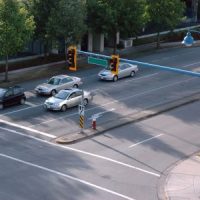Tips To Help You Avoid Accidents at Intersections

Intersections are among the most dangerous places on our roadways. Intersections involve multiple lanes, various directions of traffic, and many road users, including motorists, pedestrians, and cyclists. This increases the chances of accidents happening at intersections. The Federal Highway Administration (FHWA) estimates that over 50% of all fatal and injury collisions occur at or near intersections. Fortunately, when at an intersection, there are several steps you can take to avoid a crash. The following are some tips to keep in mind that can help reduce the risk of an accident the next time you are at an intersection.
- Lower Your Speed
Slow down when approaching an intersection. The faster your car is moving, the less time you have to react to an unexpected situation. Slowing down can allow you to stop in time if another driver fails to stop at a red light or if a pedestrian suddenly crosses the road. Driving at a lower speed also improves visibility, allowing you to evaluate your surroundings better and spot any potential hazards.
- Pay Attention to Traffic Control Devices
Before reaching an intersection, pay attention to traffic control devices. Pay attention to whether both directions get a turn signal at the same time. Determine where the turn lanes are located. You want to know what you are required to do before you get to the intersection.
- Keep a Safe Distance Between You and the Vehicle Ahead
One of the most common accidents at intersections are rear-end accidents. The vehicle in front of you may suddenly stop due to a pedestrian crossing, a red light, or something else. If you are following the car too closely or, in other words, tailgating, you may not have enough time to brake in response to the sudden stop, resulting in a rear-end accident.
- Use Your Turn Signals
Never make a turn at an intersection without signaling to the other drivers your intention to make the turn. Doing so can have disastrous consequences. When engaging your turn signal, ensure you engage the right one. Some drivers engage a left or right turn signal and then proceed in the opposite direction. If you intend to turn left, engage the left turn signal. If you want to turn right, turn on the right turn signal.
- Be Aware of Your Surroundings
When driving through an intersection, pay close attention to your surroundings. When approaching an intersection, scan for traffic signs and signals. Check to see if there are pedestrians or cyclists nearby. Ensure you check your mirrors to see if there are any vehicles behind or beside you.
- Avoid Distractions
When at an intersection, avoid distracted driving. Do not use your phone while at an intersection. Avoid eating, talking to other passengers, adjusting the radio, and other distracted driving behaviors while driving through an intersection.
When the Worst Happens
While you can control your actions, you cannot control other drivers’ behaviors. Regardless of how safely you drive, you can get involved in an intersection accident. You may be eligible to recover compensation if you are injured in an intersection accident because of another driver’s negligence.
Legal Help Is Available
Our Charleston car accident lawyer at Gus Anastopoulo Law Firm can help you after suffering injuries in an accident because of another driver’s negligence. To reach us, call 843-310-5555 or fill out our online contact form.
Source:
highways.dot.gov/research/research-programs/safety/intersection-safety#:~:text=More%20than%2050%20percent%20of%20the%20combined%20total%20of%20fatal%20and%20injury%20crashes%20occur%20at%20or%20near%20intersections
